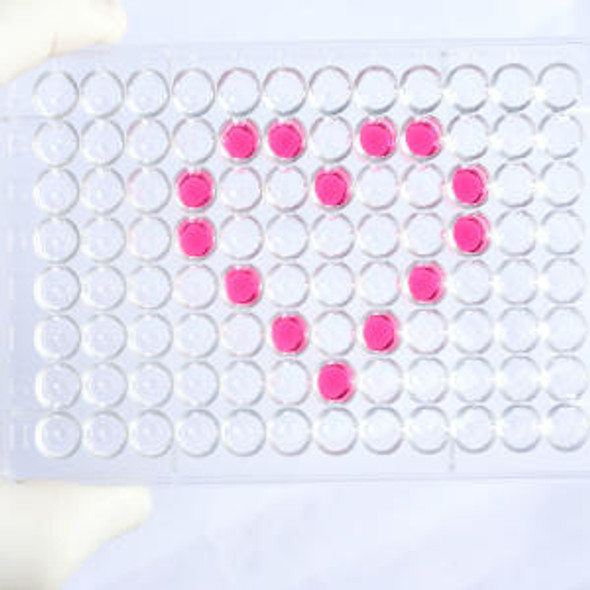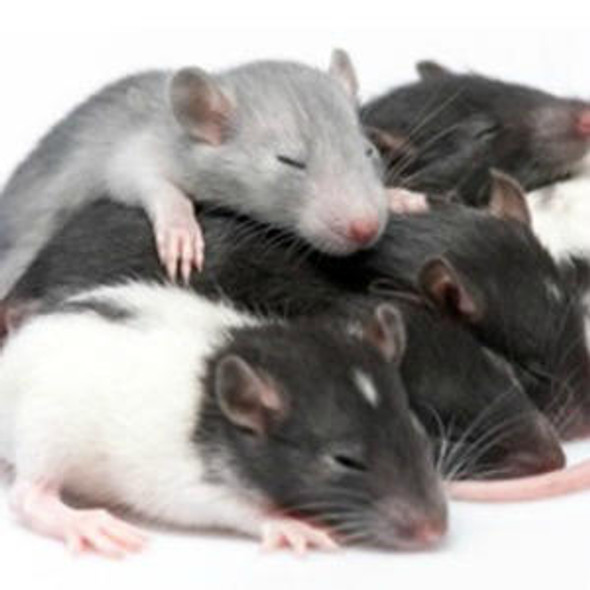Human Sorting nexin-9 / SNX9 ELISA Kit
- SKU:
- HUFI01027
- Product Type:
- ELISA Kit
- Size:
- 96 Assays
- Uniprot:
- Q9Y5X1
- Sensitivity:
- 0.188ng/ml
- Range:
- 0.313-20ng/ml
- ELISA Type:
- Sandwich ELISA, Double Antibody
- Synonyms:
- SNX9, Sorting nexin-9, SH3PX1, SH3PXD3A, MST155, MSTP155, SDP1, WISP, Protein SDP1, SH3 and PX domain-containing protein 1, SH3 and PX domain-containing protein 3A
- Reactivity:
- Human
Description
Human Sorting nexin-9 / SNX9 ELISA Kit
SNX9 belongs to the sorting nexin family. Proteins of this family contain a phosphoinositide binding domain and are involved in intracellular trafficking. SNX9 lacks a coiled coil region, like some family members, but it does contain an SRC homology domain near its N terminus. Endocytosis, macropinocytosis, and F-actin nucleation are all stages of intracellular trafficking that SNX9 is involved in. Wiskott-Aldrich syndrome and neuropathy are examples of diseases linked to SNX9.
| Product Name: | Human Sorting nexin-9 / SNX9 ELISA Kit |
| Product Code: | HUFI01027 |
| Size: | 96 Assays |
| Alias: | SNX9, Sorting nexin-9, SH3PX1, SH3PXD3A, MST155, MSTP155, SDP1, WISP, Protein SDP1, SH3 and PX domain-containing protein 1, SH3 and PX domain-containing protein 3A |
| Detection method: | Sandwich ELISA, Double Antibody |
| Application: | This immunoassay kit allows for the in vitro quantitative determination of Human SNX9 concentrations in serum plasma and other biological fluids. |
| Sensitivity: | 0.188ng/ml |
| Range: | 0.313-20ng/ml |
| Storage: | 4°C for 6 months |
| Note: | For Research Use Only |
| Recovery: | Matrices listed below were spiked with certain level of Human SNX9 and the recovery rates were calculated by comparing the measured value to the expected amount of Human SNX9 in samples. | ||||||||||||||||
| |||||||||||||||||
| Linearity: | The linearity of the kit was assayed by testing samples spiked with appropriate concentration of Human SNX9 and their serial dilutions. The results were demonstrated by the percentage of calculated concentration to the expected. | ||||||||||||||||
| |||||||||||||||||
| CV(%): | Intra-Assay: CV<8% Inter-Assay: CV<10% |
| Component | Quantity | Storage |
| ELISA Microplate (Dismountable) | 8×12 strips | 4°C for 6 months |
| Lyophilized Standard | 2 | 4°C/-20°C |
| Sample/Standard Dilution Buffer | 20ml | 4°C |
| Biotin-labeled Antibody(Concentrated) | 120ul | 4°C (Protect from light) |
| Antibody Dilution Buffer | 10ml | 4°C |
| HRP-Streptavidin Conjugate(SABC) | 120ul | 4°C (Protect from light) |
| SABC Dilution Buffer | 10ml | 4°C |
| TMB Substrate | 10ml | 4°C (Protect from light) |
| Stop Solution | 10ml | 4°C |
| Wash Buffer(25X) | 30ml | 4°C |
| Plate Sealer | 5 | - |
Other materials and equipment required:
- Microplate reader with 450 nm wavelength filter
- Multichannel Pipette, Pipette, microcentrifuge tubes and disposable pipette tips
- Incubator
- Deionized or distilled water
- Absorbent paper
- Buffer resevoir
| Uniprot | Q9Y5X1 |
| UniProt Protein Function: | SNX9: May be involved in several stages of intracellular trafficking. Plays a role in endocytosis via clathrin-coated pits, but also clathrin-independent, actin-dependent fluid-phase endocytosis. Plays a role in macropinocytosis. Promotes internalization of TNFR. Promotes degradation of EGFR after EGF signaling. Stimulates the GTPase activity of DNM1. Promotes DNM1 oligomerization. Promotes activation of the Arp2/3 complex by WASL, and thereby plays a role in the reorganization of the F- actin cytoskeleton. Binds to membranes enriched in phosphatidylinositol 4,5-bisphosphate and promotes membrane tubulation. Has lower affinity for membranes enriched in phosphatidylinositol 3-phosphate. Belongs to the sorting nexin family. |
| UniProt Protein Details: | Protein type:Vesicle Chromosomal Location of Human Ortholog: 6q25.3 Cellular Component: ruffle; extrinsic to internal side of plasma membrane; cytoplasmic vesicle membrane; clathrin-coated vesicle; cytoplasmic membrane-bound vesicle; cytoplasm; plasma membrane; trans-Golgi network; endosome Molecular Function:protein binding; protein homodimerization activity; ubiquitin protein ligase binding; phosphoinositide binding; phosphatidylinositol binding Biological Process: mitosis; intracellular protein transport; receptor-mediated endocytosis; positive regulation of protein oligomerization; cytokinesis after mitosis; positive regulation of protein kinase activity; vesicle organization and biogenesis; endocytosis; endosome transport; positive regulation of membrane protein ectodomain proteolysis; positive regulation of GTPase activity |
| NCBI Summary: | This gene encodes a member of the sorting nexin family. Members of this family contain a phosphoinositide binding domain, and are involved in intracellular trafficking. The encoded protein does not contain a coiled coil region, like some family members, but does contain a SRC homology domain near its N-terminus. The encoded protein is reported to have a variety of interaction partners, including of adaptor protein 2 , dynamin, tyrosine kinase non-receptor 2, Wiskott-Aldrich syndrome-like, and ARP3 actin-related protein 3. The encoded protein is implicated in several stages of intracellular trafficking, including endocytosis, macropinocytosis, and F-actin nucleation. [provided by RefSeq, Jul 2013] |
| UniProt Code: | Q9Y5X1 |
| NCBI GenInfo Identifier: | 12643956 |
| NCBI Gene ID: | 51429 |
| NCBI Accession: | Q9Y5X1.1 |
| UniProt Secondary Accession: | Q9Y5X1,Q9BSI7, Q9BVM1, Q9UJH6, Q9UP20, |
| UniProt Related Accession: | Q9Y5X1 |
| Molecular Weight: | 595 |
| NCBI Full Name: | Sorting nexin-9 |
| NCBI Synonym Full Names: | sorting nexin 9 |
| NCBI Official Symbol: | SNX9 |
| NCBI Official Synonym Symbols: | SDP1; WISP; SH3PX1; SH3PXD3A |
| NCBI Protein Information: | sorting nexin-9; SH3 and PX domain-containing protein 1; SH3 and PX domain-containing protein 3A; Wiskott-Aldrich syndrome protein (WASP) interactor protein |
| UniProt Protein Name: | Sorting nexin-9 |
| UniProt Synonym Protein Names: | SH3 and PX domain-containing protein 1; Protein SDP1; SH3 and PX domain-containing protein 3A |
| Protein Family: | Sorting nexin |
| UniProt Gene Name: | SNX9 |
| UniProt Entry Name: | SNX9_HUMAN |
*Note: Protocols are specific to each batch/lot. For the correct instructions please follow the protocol included in your kit.
Before adding to wells, equilibrate the SABC working solution and TMB substrate for at least 30 min at 37°C. When diluting samples and reagents, they must be mixed completely and evenly. It is recommended to plot a standard curve for each test.
| Step | Protocol |
| 1. | Set standard, test sample and control (zero) wells on the pre-coated plate respectively, and then, record their positions. It is recommended to measure each standard and sample in duplicate. Wash plate 2 times before adding standard, sample and control (zero) wells! |
| 2. | Aliquot 0.1ml standard solutions into the standard wells. |
| 3. | Add 0.1 ml of Sample / Standard dilution buffer into the control (zero) well. |
| 4. | Add 0.1 ml of properly diluted sample ( Human serum, plasma, tissue homogenates and other biological fluids.) into test sample wells. |
| 5. | Seal the plate with a cover and incubate at 37 °C for 90 min. |
| 6. | Remove the cover and discard the plate content, clap the plate on the absorbent filter papers or other absorbent material. Do NOT let the wells completely dry at any time. Wash plate X2. |
| 7. | Add 0.1 ml of Biotin- detection antibody working solution into the above wells (standard, test sample & zero wells). Add the solution at the bottom of each well without touching the side wall. |
| 8. | Seal the plate with a cover and incubate at 37°C for 60 min. |
| 9. | Remove the cover, and wash plate 3 times with Wash buffer. Let wash buffer rest in wells for 1 min between each wash. |
| 10. | Add 0.1 ml of SABC working solution into each well, cover the plate and incubate at 37°C for 30 min. |
| 11. | Remove the cover and wash plate 5 times with Wash buffer, and each time let the wash buffer stay in the wells for 1-2 min. |
| 12. | Add 90 µl of TMB substrate into each well, cover the plate and incubate at 37°C in dark within 10-20 min. (Note: This incubation time is for reference use only, the optimal time should be determined by end user.) And the shades of blue can be seen in the first 3-4 wells (with most concentrated standard solutions), the other wells show no obvious color. |
| 13. | Add 50 µl of Stop solution into each well and mix thoroughly. The color changes into yellow immediately. |
| 14. | Read the O.D. absorbance at 450 nm in a microplate reader immediately after adding the stop solution. |
When carrying out an ELISA assay it is important to prepare your samples in order to achieve the best possible results. Below we have a list of procedures for the preparation of samples for different sample types.
| Sample Type | Protocol |
| Serum | If using serum separator tubes, allow samples to clot for 30 minutes at room temperature. Centrifuge for 10 minutes at 1,000x g. Collect the serum fraction and assay promptly or aliquot and store the samples at -80°C. Avoid multiple freeze-thaw cycles. If serum separator tubes are not being used, allow samples to clot overnight at 2-8°C. Centrifuge for 10 minutes at 1,000x g. Remove serum and assay promptly or aliquot and store the samples at -80°C. Avoid multiple freeze-thaw cycles. |
| Plasma | Collect plasma using EDTA or heparin as an anticoagulant. Centrifuge samples at 4°C for 15 mins at 1000 × g within 30 mins of collection. Collect the plasma fraction and assay promptly or aliquot and store the samples at -80°C. Avoid multiple freeze-thaw cycles. Note: Over haemolysed samples are not suitable for use with this kit. |
| Urine & Cerebrospinal Fluid | Collect the urine (mid-stream) in a sterile container, centrifuge for 20 mins at 2000-3000 rpm. Remove supernatant and assay immediately. If any precipitation is detected, repeat the centrifugation step. A similar protocol can be used for cerebrospinal fluid. |
| Cell culture supernatant | Collect the cell culture media by pipette, followed by centrifugation at 4°C for 20 mins at 1500 rpm. Collect the clear supernatant and assay immediately. |
| Cell lysates | Solubilize cells in lysis buffer and allow to sit on ice for 30 minutes. Centrifuge tubes at 14,000 x g for 5 minutes to remove insoluble material. Aliquot the supernatant into a new tube and discard the remaining whole cell extract. Quantify total protein concentration using a total protein assay. Assay immediately or aliquot and store at ≤ -20 °C. |
| Tissue homogenates | The preparation of tissue homogenates will vary depending upon tissue type. Rinse tissue with 1X PBS to remove excess blood & homogenize in 20ml of 1X PBS (including protease inhibitors) and store overnight at ≤ -20°C. Two freeze-thaw cycles are required to break the cell membranes. To further disrupt the cell membranes you can sonicate the samples. Centrifuge homogenates for 5 mins at 5000xg. Remove the supernatant and assay immediately or aliquot and store at -20°C or -80°C. |
| Tissue lysates | Rinse tissue with PBS, cut into 1-2 mm pieces, and homogenize with a tissue homogenizer in PBS. Add an equal volume of RIPA buffer containing protease inhibitors and lyse tissues at room temperature for 30 minutes with gentle agitation. Centrifuge to remove debris. Quantify total protein concentration using a total protein assay. Assay immediately or aliquot and store at ≤ -20 °C. |
| Breast Milk | Collect milk samples and centrifuge at 10,000 x g for 60 min at 4°C. Aliquot the supernatant and assay. For long term use, store samples at -80°C. Minimize freeze/thaw cycles. |










